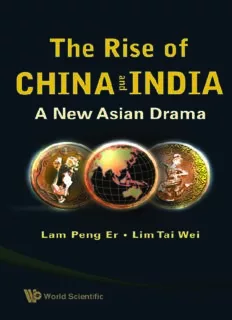
The Rise of China and India: A New Asian Drama PDF
Preview The Rise of China and India: A New Asian Drama
The Rise of China india a n d A New Asian Drama TThhiiss ppaaggee iinntteennttiioonnaallllyy lleefftt bbllaannkk The Rise of China india a n d A New Asian Drama Lam Peng Er Lim Tai Wei East Asian Institute, National University of Singapore, Singapore World Scientific NEW JERSEY • LONDON • SINGAPORE • BEIJING • SHANGHAI • HONG KONG • TAIPEI • CHENNAI Published by World Scientific Publishing Co. Pte. Ltd. 5 Toh Tuck Link, Singapore 596224 USA office: 27 Warren Street, Suite 401-402, Hackensack, NJ 07601 UK office: 57 Shelton Street, Covent Garden, London WC2H 9HE British Library Cataloguing-in-Publication Data A catalogue record for this book is available from the British Library. THE RISE OF CHINA AND INDIA A New Asian Drama Copyright © 2009 by World Scientific Publishing Co. Pte. Ltd. All rights reserved. This book, or parts thereof, may not be reproduced in any form or by any means, electronic or mechanical, including photocopying, recording or any information storage and retrieval system now known or to be invented, without written permission from the Publisher. For photocopying of material in this volume, please pay a copying fee through the Copyright Clearance Center, Inc., 222 Rosewood Drive, Danvers, MA 01923, USA. In this case permission to photocopy is not required from the publisher. ISBN-13 978-981-4280-33-4 ISBN-10 981-4280-33-X Typeset by Stallion Press Email: [email protected] Printed in Singapore. Sandhya - The Rise of China and India.pmd 1 9/2/2009, 7:40 PM b774_FM.qxd 5/6/2009 9:42 AM Page v Acknowledgements The genesis of this book was based on the Mahatma Gandhi–Daisaku Ikeda Peace Research Conference on “The Rise of China and India: Towards a Harmonious Region?” in August 2008. This conference was organized by the East Asian Institute (EAI), Singapore and gen- erously sponsored by Lam Kin-chung Morning Sun Charity Fund and Dr Ho Hau Wong. Besides our profound thanks to our sponsors, the editors are also grateful to Professor Wang Gungwu, Chairman of EAI, Professor Zheng Yongnian, Director of EAI and Professor John Wong, Director of Research at EAI for their kind support to bring this project into fruition. We extend our appreciation to the World Scientific editorial team for bringing this edited volume out in a timely manner. v b774_FM.qxd 5/6/2009 9:42 AM Page vi TThhiiss ppaaggee iinntteennttiioonnaallllyy lleefftt bbllaannkk b774_FM.qxd 5/6/2009 9:42 AM Page vii Contents Acknowledgements v Chapter 1 Introduction: China, India and the 1 New Asian Drama Lam Peng Er and Lim Tai Wei Chapter 2 The Rise of China: Conflict or Harmony 11 in East Asia? Ding Dou Chapter 3 Emerging India and China: Potentials 21 and Constraints K. M. Seethi Chapter 4 The Rise of China and India and Its 39 Implications for Southeast Asia: A Philippine Perspective Noel M. Morada Chapter 5 Negotiating the Rise of Asia — A Perspective 59 from Malaysia’s Relations with India and China Johan Saravanamuttu vii b774_FM.qxd 5/6/2009 9:42 AM Page viii viii ✦✦ Contents Chapter 6 A Japanese Perspective on the Rise of China 79 and India: Opportunities, Concerns, and Potential Threats Minoru Koide Chapter 7 The Rise of China and India: Geo-political 99 Narratives from the Singapore Perspective Lim Tai Wei Chapter 8 The Rise of China and India and Its 127 Implications for Southeast Asia: A Thai Perspective Prapat Thepchatree Bibliography 147 Index 161 b774_Chapter-01.qxd 4/24/2009 3:21 PM Page 1 Chapter 1 Introduction: China, India and the New Asian Drama Lam Peng Er and Lim Tai Wei In 1968, Karl Gunnar Myrdal, a Swedish economist, politician and Nobel laureate wrote his landmark study Asian Drama: An Inquiry into the Poverty of Nations.1This work pessimistically analyzed the dif- ficulties of development in South Asia and the widening gap between rich and poor nations, and concluded that the Asian drama could well turn out to be a tragedy. In the same year the Asian Drama was pub- lished, India was mired in economic stagnation and Maoist China was in the throes of the self-inflicted Cultural Revolution. Few could have imagined from the vantage point of 1968 that barely four decades later a new and contrarian Asian Drama would unfold — the rise of China and India on the global stage. Both countries are emerging economic power houses, autonomous great powers in their respective regions, and are major civilizations. Indeed, they have exercised cultural “soft power” in Southeast Asia for more than a millennium. In 2008, China put on a spectacular display and a great feat of organization at the Beijing Summer Olympics and succeeded in stunning and wooing a global audience. The importance of these two Asian giants can hardly be exagger- ated. Combined, their population comprises more than a third of 1 Karl Gunnar Myrdal, Asian Drama: An Inquiry into the Poverty of Nations, 3 Vols.(New York: Pantheon Books, 1968). 1
Description: